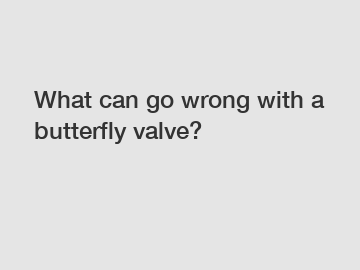What can go wrong with a butterfly valve?
Butterfly valves are commonly used in various industries for regulating or isolating the flow of liquids and gases. While they are known for being reliable and versatile, there are certain issues that can arise with butterfly valves. Understanding these potential problems can help users address them promptly and effectively.
**Corrosion and Wear**.
One common issue that can affect butterfly valves is corrosion. Corrosion can occur due to exposure to corrosive fluids or environments, leading to deterioration of the valve components. This can result in leaks, reduced performance, or complete valve failure. Regular maintenance and inspections can help prevent corrosion by identifying any signs of wear early on.

**Seat Leakage**.
Another problem that can arise with butterfly valves is seat leakage. Seat leakage occurs when the valve's seat does not provide a tight seal, allowing fluid to leak past the closure element. This can result in inefficiencies in the system, loss of product, or even safety hazards. Regular testing of the valve's seat and proper installation can help prevent seat leakage.
**Improper Installation**.
Improper installation of butterfly valves can lead to a host of issues. If the valve is not installed correctly, it may not operate as intended, leading to leaks, poor performance, or premature wear. It is essential to follow the manufacturer's guidelines for installation and ensure that the valve is properly aligned, supported, and connected to the system.
**Throttling and Cavitation**.
Butterfly valves are not designed for precise throttling applications. Attempting to use a butterfly valve for throttling purposes can lead to poor control of flow, excessive wear on the valve components, and reduced valve life. Additionally, cavitation can occur when the fluid pressure drops too low, causing bubbles to form and implode within the valve. This can cause erosion, noise, and damage to the valve over time.
**High Temperatures and Pressures**.
Butterfly valves have temperature and pressure limitations that users must be aware of. Exceeding these limits can cause the valve components to fail, leading to leaks, system failures, or potential safety hazards. It is essential to select a valve that is suitable for the operating conditions of the system and to monitor temperature and pressure levels to avoid damage to the valve.
**Conclusion**.
In conclusion, while butterfly valves are a popular choice for flow control applications, there are several potential issues that users should be aware of. Corrosion, seat leakage, improper installation, throttling, cavitation, and high temperatures and pressures can all impact the performance and reliability of butterfly valves. Regular maintenance, proper installation, and selecting the right valve for the application can help prevent these issues from occurring. By addressing potential problems early on, users can ensure that their butterfly valves operate efficiently and effectively.
If you are experiencing any issues with your butterfly valve or have questions about proper maintenance and installation, please do not hesitate to contact us. Our team of experts is here to help you address any concerns and ensure that your valve operates optimally.
For more information, please visit China bellows gate valve manufacturer, globe vs gate valve, China marine butterfly valves factory.
116
0
0


Comments
All Comments (0)